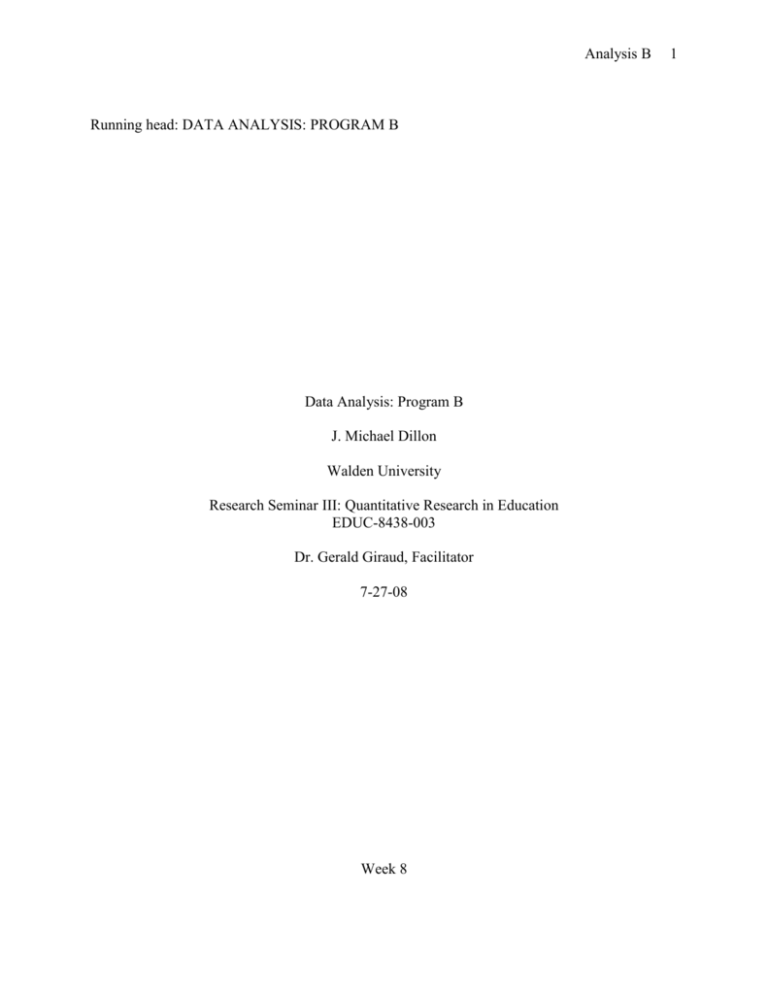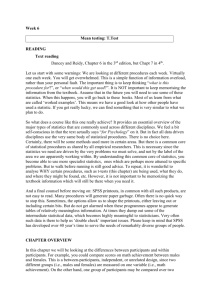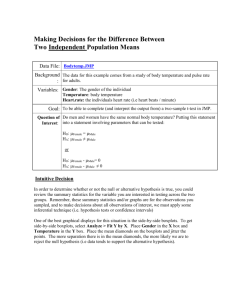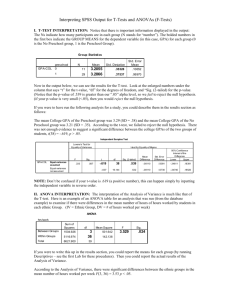
Analysis B
Running head: DATA ANALYSIS: PROGRAM B
Data Analysis: Program B
J. Michael Dillon
Walden University
Research Seminar III: Quantitative Research in Education
EDUC-8438-003
Dr. Gerald Giraud, Facilitator
7-27-08
Week 8
1
Analysis B
2
Data Analysis: Program B
Hypothesis testing is a major part of inferential statistics. The techniques associated with
hypothesis testing allow researchers to use data and statistical analysis to produce evidence the
either supports or rejects a given claim. These types of conjectures can range from questions
about means and proportions in a sample to comparisons between treatment and control groups.
The following exercises utilize SPSS software to answer questions involving t-tests in variety of
different scenarios.
One-Sample t-Test (page 160)
John is interested in determining if a new teaching method, the Involvement Technique, is
effective in teaching algebra to first graders. John randomly samples six first graders from all
first graders within the Lawrence City School System and individually teaches them algebra with
the new method. Next, the pupils complete an eight-item algebra test. Each item describes a
problem and presents four possible answers to the problem. The scores on each item are 1 or 0
where 1 indicates a correct response, and 0 indicates a wrong response. The SPSS data file
contains six cases, each with eight item scores for the algebra test.
Exercise 1: Compute total scores for the algebra test from the item scores. A one-sample t test
will be computed on the total scores.
Student
Total Score
A
8
B
6
C
5
D
7
E
4
F
6
Exercise 2: What is the test value for this problem?
Each question has four possible choices. If a student were to randomly guess, he or she
would have one in four chance of getting the answer correct. Therefore, the test value for
this scenario would be 2 (0.25 8 = 2) since this score would be expected based solely
on chance.
Exercise 3: Conduct a one-sample t test on the total scores. On the output, identify the following:
a) Mean algebra score
b) t-test value
c) p value
Output from SPSS
Mean = 6.0000
One-Sample Statistics
N
total
6
Mean
6.0000
Std. Deviation
1.41421
Std. Error
Mean
.57735
Analysis B
3
One-Sample Test
Test Value = 2
tot al
t
6.928
df
5
Sig. (2-tailed)
.001
t-test value = 6.928
Mean
Difference
4.00000
95% Confidenc e
Int erval of t he
Difference
Lower
Upper
2.5159
5.4841
p-value = 0.001
a) The mean of the total test scores is 6.000
b) The t-test value is 6.928.
c) The p-value is 0.001
Exercise 4: Given the results of the children’s performance on the test, what should John
conclude? Write a results section based on your analyses.
A one-sample t test was conducted on the total scores of the eight-item algebra test to
evaluate whether their mean was significantly different from 2, the score that would be
expected based solely on chance (random guessing between 4 possible answers). The
sample mean of 6.00 (SD = 1.41) was significantly different from 2, t(5) = 6.928, p =
0.001. The 95% confidence interval for the total score mean ranged from 4.52 to 7.48.
The effect size of d of 2.83 indicates a large effect from the treatment. The results of the
test support the conclusion that the Involvement Technique was successful in helping the
first-grade students learn algebra.
Paired-Samples t-Test (page 166)
Kristy is interested in investigating whether husbands and wives who are having infertility
problems feel equally anxious. She obtains the cooperation of 24 infertile couples. She then
administers the Infertility Anxiety Measure (IAM) to both the husbands and the wives. Her
SPSS data file contains 24 cases, one for each husband-wife pair, and two variables, the IAM
scores for the husbands and the IAM score for the wives.
Exercise 6: Conduct a paired-samples t test on these data. On the output, identify the following:
a) mean IAM (husbands)
b) mean IAM (wives)
c) t test value
d) p-value
Output from SPSS
Analysis B
4
Paired Samples Statistics
Mean
Pair
1
Husband's infertility
anxiety score
Wife's infertility
anxiety score
N
Std. Deviation
Std. Error
Mean
57.46
24
7.337
1.498
62.54
24
12.441
2.540
Mean IAM for
husbands = 57.46
Mean IAM for
wives = 57.46
Paired Samples Correlations
N
Pair
1
Husband's infertility
anxiety score & Wife's
infertility anxiety score
Correlation
24
Sig.
.822
.000
Pa ired Sa mpl es Test
Paired Differenc es
Mean
Pair
1
Husband's infertility
anxiety score - Wife's
infertility anxiet y sc ore
-5. 083
St d. Deviat ion
St d. Error
Mean
7.649
1.561
95% Confidenc e
Int erval of t he
Difference
Lower
Upper
-8. 313
-1. 853
t-test value = –3.256
a)
b)
c)
d)
t
df
-3. 256
Sig. (2-tailed)
23
p value = 0.003
The mean IAM scores for husbands is 57.46.
The mean IAM scores for wives is 62.54.
The t test value is –3.256.
The p value is 0.003.
Exercise 7: Write a Results section in APA style based on your output.
A paired-samples t test was conducted to evaluate if husbands or wives who are infertile
experience the same level of anxiety. The results indicated that the mean IAM score (an anxiety
measure) for women (M = 62.54, SD = 12,44) was significantly greater than the mean IAM score
for men (M = 57.46, SD = 7.34), t(23) = –3.256, p < 0.01. The standardized effect size index, d,
was 0.66, with considerable overlap in the distribution for the IAM scores for husbands and
wives, as shown in Figure 1. The 95% confidence interval for the mean difference between the
two ratings was –8.31 to –1.85.
.003
Analysis B
5
90
2
80
2
70
60
50
21
40
Husband's infertility anxiety score
Wife's infertility anxiety score
Figure 1. Boxplots of IAM scores for husbands and wives.
Independent-Samples t-Test (page 173)
Billie wishes to test the hypothesis that overweight individuals tend to eat faster than normal
weight individuals. To test this hypothesis, she has two assistants sit in a McDonald’s restaurant
and identify individuals who order the Big Mac special (Big Mac, large fries, and large Coke) for
lunch. The Big Mackers, as they are affectionately called by the assistants, are classified as
overweight, normal weight, or neither overweight nor normal weight. The assistants identify 10
overweight and 30 normal weight Big Mackers. The assistants record the amount of time it takes
for the individuals to complete their Big Mac special meals. The SPSS data file contains two
variables, a grouping variable with two levels, overweight (= 1) and normal weight (= 2), and
time in seconds to eat the meal.
Exercise 1: Compute an independent-samples t test on these data. Report the t-values and the p
values assuming equal population variances and not assuming equal population variances.
For purposes of the SPSS calculations, the individuals identified as overweight were
considered to be group 1 and the individuals identified as normal weight were considered
to be group 2. The negative values for the t test value result from the fact that group 1
had smaller times. For assumption of equal population variances, the t test value is:
–3.975 and the p-value = 0.000. If it is not assumed that there are equal population
variances, the t test value is –5.397 and the p-value = 0.000.
Analysis B
6
Exercise 2: On the output, identify the following:
a) Mean eating time for overweight individuals
b) Standard deviation for normal weight individuals
c) Results for the test evaluating homogeneity of variances
Output from SPSS
Group Statistics
Time s pent eating Big
Mac specials in seconds
Weight clas sification
overweight
normal weight
N
Mean
589.00
698.40
10
30
Std. Error
Mean
13.476
15.144
Std. Deviation
42.615
82.949
Mean eating time for
overweight individuals = 589
Standard deviation for normal
weight individuals = 82.949
Independent Samples Test
Levene's Test for
Equality of Variances
F
Time s pent eating Big
Mac specials in seconds
Equal variances
as sumed
Equal variances
not ass umed
Sig.
2.745
.106
t-test for Equality of Means
t
df
Sig. (2-tailed)
Mean
Difference
Std. Error
Difference
95% Confidence
Interval of the
Difference
Lower
Upper
-3.975
38
.000
-109.400
27.522
-165.116
-53.684
-5.397
30.828
.000
-109.400
20.272
-150.754
-68.046
Test for evaluating homogeneity of
variances: F = 2.746 and p = 0.106
a) The mean eating time overweight individuals is 589.00.
b) The standard deviation for normal weight individuals is 82.949.
c) The results for the test evaluating homogeneity of variances are: F = 2.745 and p =
0.106
Exercise 3: Compute an effect size that describes the magnitude of the relationship between
weight and the speed of eating Big Mac meals.
Since both the sample sizes are the variances are different, use the t test value from the
calculation where equal variances are not assumed. To calculate the effect size, use the
following process:
d t
N1 N 2
10 30
40
5.397
5.397
5.397 0.13
N1 N 2
10 30
300
5.397 0.365 1.9707057619 1.971 ignore sign 1.971
Analysis B
7
The effect size would be considered to be larger (greater than 0.8).
Exercise 5: If you did not include a graph in your Results section, create a graph in APA format
that shows the differences between the two groups.
Time spent eating Big Mac specials in seconds
750
700
650
600
550
overweight
normal weight
Weight classification
Figure 2. Error bars for time spent eating Big Mac meals for each weight group.
Requirement for Each Test
The following table outlines the requirements for each type of t test and provides example
of situations where the test could be applied:
Analysis B
Requirements
Test
(referenced from Green and Salkind)
One-Sample
t-Test
Paired-Samples
t-Test
Independent-Samples
t-Test
Variables must come from a
normally distributed population
Randomly sampled
Each value must be independent
The scores for the differences
between the means must come
from a normally distributed
population
Randomly sampled
Each difference value must be
independent
The variable must be normally
distributed in each sample
Randomly sampled
An assumption about the
variances for each sample must
be made (differences can result
if the variances are equal versus
if they are not equal
8
Example
An example where a one-sample ttest might be used would be to test
the assumption that a group of
students who receive additional
instruction score above average on
the math portion of the ITED
(Iowa Test of Educational
Development) test. In this case,
the mean of the group of student is
being compared to population
mean.
An example of a situation where a
paired-samples t-test would be
used is if students were asked to
complete a survey regarding their
attitudes about mathematics before
and after a new teaching technique
is implemented to improve math
instruction for a given unit. It is a
paired-samples situation because
data is collected from each student
twice and these data are compared.
An example of an independentsamples t-test would be to compare
data between two separate groups
where one group receives
additional instruction beyond the
normal amount prior to a calculus
test and a control group receives
just the normal amount.
Analysis B
References
Green, S. B., & Salkind, N. J. (2005). Using SPSS for Windows and Macintosh: Analyzing and
understanding data (4th ed.). Upper Saddle River, NJ: Pearson Prentice-Hall.
9









